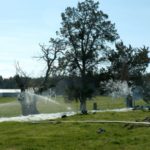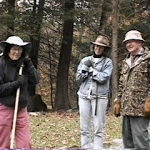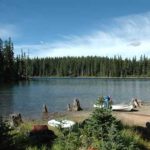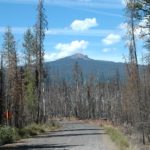What’s a vault?

Once upon a time we were asked, “What is a “vault? Isn’t it where the Forest Service puts important papers?”
A reasonable question for someone unfamiliar with the vocabulary used by the Forest Service. For Fred and I it was the question that demonstrated a need for a glossary of terms to go with our website, forestcamping.com and Guides.
Although neither Fred or I have been Forest Service employees, it seemed logical for use to adopt the Forest Service’s vocabulary when we began our research in 1994. Without the Forest Service vocabulary, we might describe a campground as having, “A dense crown of vegetation from trees, which loose leaves on a seasonal basis, provide ample shade to camp sites that can accommodate campers using cars, tents, and/or a variety of recreational vehicles.” But using the Forest Service terms this campground’s description would be, “A dense over-story from deciduous trees provide ample shade to the multi-use campsites.” Using terms like conifer trees, hand pumps, and ramada rather then softwood trees which retain their needle-leaves year round, a mechanical device used to draw water from a well, and a shade producing roofed structure with open sides seemed appropriate is much less wordy. But it works only if the reader understands the vocabulary.
We use words to describe a national forest to people who are interested in visiting but unfamiliar with the area or its campground. A photograph may be worth a thousand words but, when we began back in 1994, technical limitations meant verbal description the only viable means. Words such as canopy, middle-story, under-story, tent pad, open site, water buffalo, dispersed camping, and pack-it-in/pack-it-out help to “draw” an image but again, only if you know the vocabulary. After all, who would think having a water buffalo near their camp site is a good thing?
Outside the campground there is another set of terms. Chaparral, rain shadow, and riparian are just a few terms used to describe the area surrounding a campground. They may accurately describe the land but without knowing the meaning, using of these terms would be like trying to describe a sunset to a blind man.
Perhaps the most controversial terms used by the Forest Service deals with managing and harvesting trees. Shelterwood cutting (40 to 60% of the trees are selectively cut so the remaining trees provide some habitat for vegetation and wildlife), clearcut (all trees with a 1-inch or larger diameter are removed), and prescribed or controlled burn (monitored fire used to reduce ground litter, such as leaves, needles, and pine cones, or burnable material on the forest’s floor) are words used familiar to members of the Forest Service. These terms describe a few of many techniques used by the Forest Service to manage and maintain healthy forests and may be seen by visitors to a forest. However, to most non-Forest Service such words have little meaning without a dictionary.
Curious about the meaning of a terms used in this blog or by the Forest Service? Please check the Glossary at the U.S. National Forest Campground Guide website (www.forestcamping.com). Can’t find it there, just email the term to us and we’ll be happy to define it for you.
BTW, a “vault” maybe the most important and necessary part of a campground and is sometimes called an outhouse or pit toilet. The Forest Service also uses the term SST for some vaults. This term means “Sweet Smelling Toilet” but it is still an outhouse.






